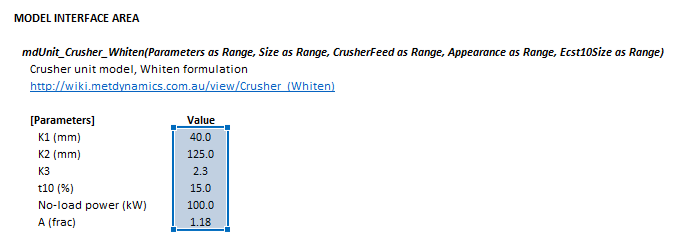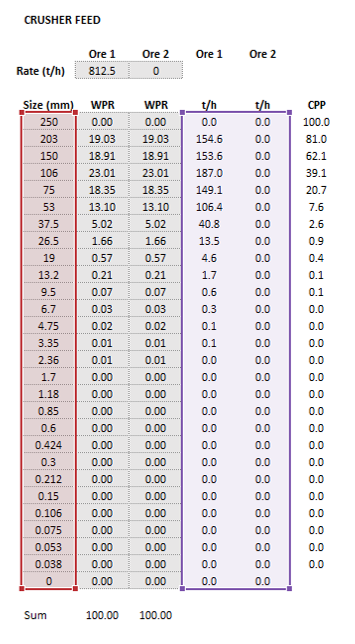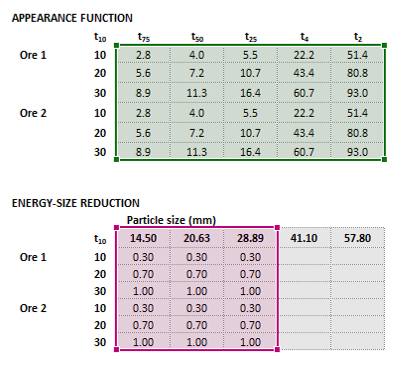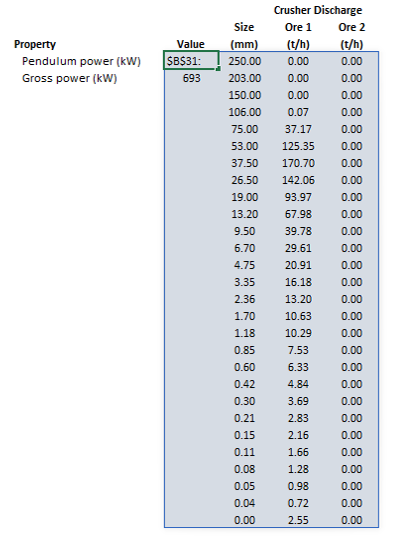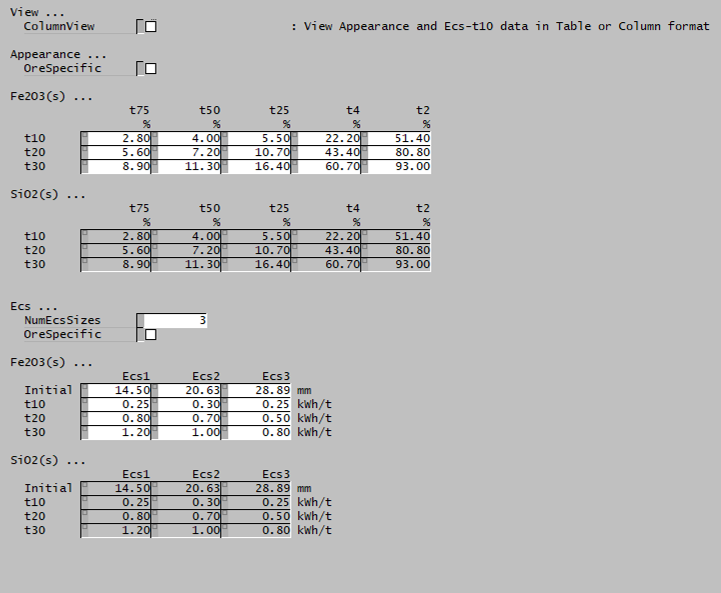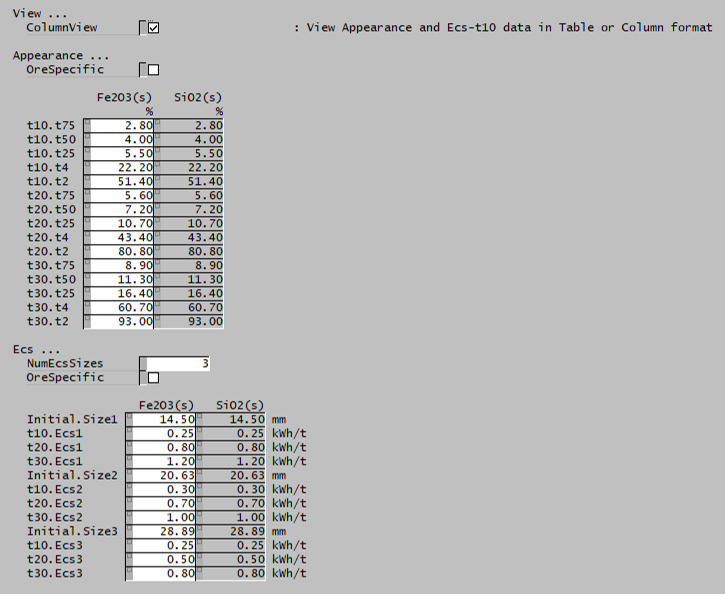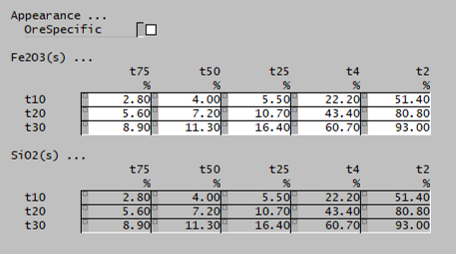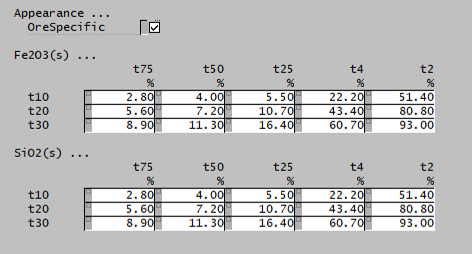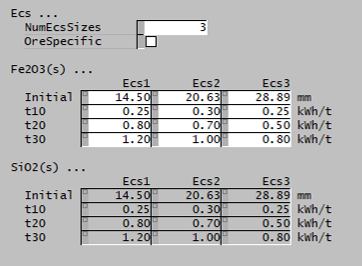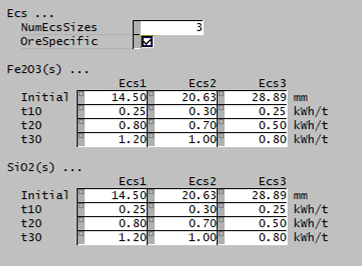Crusher (Whiten): Difference between revisions
Scott Munro (talk | contribs) m (→Classification) |
md>Scott.Munro m (→Results) |
||
| Line 1: | Line 1: | ||
== Description == | == Description == | ||
This | This article describes an implementation of the '''Whiten crusher model''' outlined by Napier-Munn et al.{{Napier-Munn_et_al._(1996)}} | ||
The model is useful for simulating the product particle size distribution and power draw of gyratory, jaw, cone, and impact crushers. | The model is useful for simulating the product particle size distribution and power draw of gyratory, jaw, cone, and impact crushers. | ||
== Model | == Model theory == | ||
The Whiten formulation considers the crushing of particles as a series of repetitive events where particles are selected or 'classified', for breakage, broken and reselected as they transit the narrowing crushing chamber. | The Whiten formulation considers the crushing of particles as a series of repetitive events where particles are selected or 'classified', for breakage, broken and reselected as they transit the narrowing crushing chamber. | ||
The cycle of classification and breakage events can be represented as a steady-state mass balance, as shown in | The cycle of classification and breakage events can be represented as a steady-state mass balance of stream vectors, as shown in Figure 1 below: | ||
:{| | |||
|<gallery mode="nolines" widths=700px heights=150px> | |||
File:CrusherWhiten1.png|Figure 1. Schematic diagram of the breakage and classification processes in the Whiten crusher model. | |||
</gallery> | |||
|} | |||
A mass balance of particle mass flows around the stream <math>X</math> yields: | A mass balance of particle mass flows around the stream <math>X</math> yields: | ||
:<math>X=F+B\cdot C\cdot X</math> | :<math>X=F+B \cdot C \cdot X</math> | ||
:<math>X=P+C\cdot X</math> | :<math>X=P+C\ \cdot X</math> | ||
Solving these simultaneous equations results in the Whiten crusher model: | Solving these simultaneous equations results in the Whiten crusher model: | ||
:<math>P=(I-C)\cdot (I-B\cdot C)^{-1}\cdot F</math> | :<math>P=(I-C) \cdot (I-B \cdot C)^{-1} \cdot F</math> | ||
where: | where: | ||
| Line 41: | Line 43: | ||
:<math> C_i = | :<math> C_i = | ||
\begin{cases} | |||
\begin{ | 0 & \text{for }\bar d_i<K_1\\ | ||
0 & \ | 1 - \left [ \dfrac{\bar d_i-K_2}{K_1-K_2} \right ]^{K_3} & \text{for }K_1<\bar d_i<K_2\\ | ||
1 - \left [ \ | 1 & \text{for }\bar d_i>K_2 | ||
1 & \ | \end{cases} | ||
\end{ | |||
</math> | </math> | ||
where: | where: | ||
* <math>i</math> is the index of the size interval, <math>i = \{1,2,\dots,n\}</math>, <math>n</math> is the number of size intervals | |||
* <math>C_i</math> is the mass fraction of particles of size interval <math>i</math> that are classified for breakage | * <math>C_i</math> is the mass fraction of particles of size interval <math>i</math> that are classified for breakage | ||
* <math>\bar d_i</math> is the geometric mean size of particles in size interval <math>i</math> | * <math>\bar d_i</math> is the [[Conversions|geometric mean size]] of particles in size interval <math>i</math> | ||
* <math>K_1</math> is the size below which all particles are not selected for breakage and report directly to product | * <math>K_1</math> is the size below which all particles are not selected for breakage and report directly to product | ||
* <math>K_2</math> is the size above which all particles are always selected for breakage | * <math>K_2</math> is the size above which all particles are always selected for breakage | ||
| Line 66: | Line 66: | ||
Each element of the Appearance Function matrix, <math>t_{ij}</math> represents the percentage fraction of progeny particles passing one-<math>j</math>th of the original parent particle geometric mean size, when <math>i</math>% of the products pass one-tenth of the original product size (i.e. the <math>t_{10}</math>). | Each element of the Appearance Function matrix, <math>t_{ij}</math> represents the percentage fraction of progeny particles passing one-<math>j</math>th of the original parent particle geometric mean size, when <math>i</math>% of the products pass one-tenth of the original product size (i.e. the <math>t_{10}</math>). | ||
The Appearance Function for a particular ore is typically obtained from a JK Drop Weight test. An example is shown below: | The Appearance Function for a particular ore is typically obtained from a JK Drop Weight test. An example is shown in Table 1 below: | ||
:{| class="wikitable" | :{| class="wikitable" | ||
|+ Example | |+ Table 1. Example Appearance Function data | ||
! | ! | ||
!<math>t_{75}(%)</math> | !<math>t_{75}(\%)</math> | ||
!<math>t_{50}(%)</math> | !<math>t_{50}(\%)</math> | ||
!<math>t_{25}(%)</math> | !<math>t_{25}(\%)</math> | ||
!<math>t_{4}(%)</math> | !<math>t_{4}(\%)</math> | ||
!<math>t_{2}(%)</math> | !<math>t_{2}(\%)</math> | ||
|- | |- | ||
|<math>t_{10}=10%</math> | |<math>t_{10}=10\%</math> | ||
|2.8 | |2.8 | ||
|4.0 | |4.0 | ||
| Line 84: | Line 84: | ||
|51.4 | |51.4 | ||
|- | |- | ||
|<math>t_{10}=20%</math> | |<math>t_{10}=20\%</math> | ||
|5.6 | |5.6 | ||
|7.2 | |7.2 | ||
| Line 91: | Line 91: | ||
|80.8 | |80.8 | ||
|- | |- | ||
|<math>t_{10}=30%</math> | |<math>t_{10}=30\%</math> | ||
|8.9 | |8.9 | ||
|11.3 | |11.3 | ||
| Line 107: | Line 107: | ||
Crusher power, <math>P_c</math> is related to the equivalent power required by a laboratory impact device (the drop weight) to achieve the same degree of breakage, and the no-load or idling power of a crusher by the following equation: | Crusher power, <math>P_c</math> is related to the equivalent power required by a laboratory impact device (the drop weight) to achieve the same degree of breakage, and the no-load or idling power of a crusher by the following equation: | ||
:<math>P_c=AP_p | :<math>P_c = P_n + AP_p</math> | ||
where: | where: | ||
* <math>P_c</math> is the power drawn by the full scale crusher | * <math>P_c</math> is the power drawn by the full scale crusher | ||
* <math>P_n</math> is the power draw of the full scale crusher machine when under no load | * <math>P_n</math> is the power draw of the full scale crusher machine when under no load | ||
* <math>P_p</math> is the 'pendulum' power, calculated as described below | |||
* <math>A</math> is a scaling factor to account for the difference between the laboratory drop weight test and full scale crusher machine | * <math>A</math> is a scaling factor to account for the difference between the laboratory drop weight test and full scale crusher machine | ||
The mass of particles selected for breakage is described by the <math>C\cdot X</math> quantity, which from the Whiten crusher model equation yields: | The mass of particles selected for breakage is described by the <math>C\cdot X</math> quantity, which from the Whiten crusher model equation yields: | ||
:<math>C\cdot X=C\cdot (I-B\cdot C)^{-1}\cdot F</math> | :<math>C \cdot X=C \cdot (I-B \cdot C)^{-1} \cdot F</math> | ||
Therefore, the total power, <math>P_c</math>, consumed by the breakage of particles in the crusher may be computed from: | Therefore, the total power, <math>P_c</math>, consumed by the breakage of particles in the crusher may be computed from: | ||
:<math>P_c=A \sum_{i=1}^{n}{C_i\cdot ((I-B\cdot C)^{-1})_i\cdot F_i\cdot\ Ecs_{i}} | :<math>P_c= P_n + A \sum_{i=1}^{n}{C_i \cdot ((I-B \cdot C)^{-1})_i \cdot F_i \cdot\ Ecs_{i}}</math> | ||
where <math>Ecs_{i}</math> is the specific comminution energy, or the energy per unit mass consumed by the breakage of a particle of size interval <math>i</math> of <math>n</math> total intervals, at a given value of <math>t_{10}</math>. | where <math>Ecs_{i}</math> is the specific comminution energy, or the energy per unit mass consumed by the breakage of a particle of size interval <math>i</math> of <math>n</math> total intervals, at a given value of <math>t_{10}</math>. | ||
A JK Drop Weight test typically provides the ''Energy-Size Reduction'' relationship for an ore, a matrix of <math>E_{cs}</math> values for three or five parent particle sizes and three <math>t_{10}</math> breakage extents, as | A JK Drop Weight test typically provides the ''Energy-Size Reduction'' relationship for an ore, a matrix of <math>E_{cs}</math> values for three or five parent particle sizes and three <math>t_{10}</math> breakage extents, as illustrated in Table 2 below: | ||
:{| class="wikitable" | :{| class="wikitable" | ||
|+ Example | |+ Table 2. Example Energy-Size Reduction relationship | ||
|- | |- | ||
! Particle size (mm) !! 14.5 !! 20.63 !! 28.89 | ! Particle size (mm) !! 14.5 !! 20.63 !! 28.89 | ||
| Line 134: | Line 134: | ||
! !! <math>E_{cs}</math> (kWh/t) !! <math>E_{cs}</math> (kWh/t) !! <math>E_{cs}</math> (kWh/t) | ! !! <math>E_{cs}</math> (kWh/t) !! <math>E_{cs}</math> (kWh/t) !! <math>E_{cs}</math> (kWh/t) | ||
|- | |- | ||
| <math>t_{10}=10%</math>|| 0.35|| 0.30|| 0.25 | | <math>t_{10}=10\%</math>|| 0.35|| 0.30|| 0.25 | ||
|- | |- | ||
| <math>t_{10}=20%</math>|| 0.80|| 0.70|| 0.50 | | <math>t_{10}=20\%</math>|| 0.80|| 0.70|| 0.50 | ||
|- | |- | ||
| <math>t_{10}=30%</math>|| 1.2|| 1.00|| 0.80 | | <math>t_{10}=30\%</math>|| 1.2|| 1.00|| 0.80 | ||
|} | |} | ||
| Line 151: | Line 151: | ||
==Excel== | ==Excel== | ||
The Whiten Crusher model may be invoked from the Excel | The Whiten Crusher model may be invoked from the Excel formula bar with the following function call: | ||
<syntaxhighlight lang="vb">=mdUnit_Crusher_Whiten(Parameters as Range, Size as Range, CrusherFeed as Range, Appearance as Range, Ecst10Size as Range)</syntaxhighlight> | |||
{{Excel (Text, Help, No Arguments)}} | |||
=== Inputs === | === Inputs === | ||
{{Excel (Text, Inputs)}} | |||
:<math>Parameters= | :<math>Parameters= | ||
| Line 177: | Line 177: | ||
CrusherFeed= \begin{bmatrix} | CrusherFeed= \begin{bmatrix} | ||
(Q_m^F)_{11}\text{ (t/h)} & \dots & (Q_m^F)_{1m}\text{ (t/h)}\\ | |||
\vdots & \ddots & \vdots\\ | \vdots & \ddots & \vdots\\ | ||
(Q_m^F)_{n1}\text{ (t/h)} & \dots & (Q_m^F)_{nm}\text{ (t/h)}\\ | |||
\end{bmatrix} | \end{bmatrix} | ||
</math> | </math> | ||
| Line 186: | Line 186: | ||
Appearance= \begin{bmatrix} | Appearance= \begin{bmatrix} | ||
\begin{bmatrix} | \begin{bmatrix} | ||
t_{75} | (t_{75})_{10}\text{ (}\%\text{)} & (t_{50})_{10}\text{ (}\%\text{)} & (t_{25})_{10}\text{ (}\%\text{)} & (t_{4})_{10}\text{ (}\%\text{)} & (t_{2})_{10}\text{ (}\%\text{)}\\ | ||
t_{75} | (t_{75})_{20}\text{ (}\%\text{)} & (t_{50})_{20}\text{ (}\%\text{)} & (t_{25})_{20}\text{ (}\%\text{)} & (t_{4})_{20}\text{ (}\%\text{)} & (t_{2})_{20}\text{ (}\%\text{)}\\ | ||
t_{75} | (t_{75})_{30}\text{ (}\%\text{)} & (t_{50})_{30}\text{ (}\%\text{)} & (t_{25})_{30}\text{ (}\%\text{)} & (t_{4})_{30}\text{ (}\%\text{)} & (t_{2})_{30}\text{ (}\%\text{)}\\ | ||
\end{bmatrix}_1\\ | \end{bmatrix}_1\\ | ||
\vdots\\ | \vdots\\ | ||
\begin{bmatrix} | \begin{bmatrix} | ||
t_{75} | (t_{75})_{10}\text{ (}\%\text{)} & (t_{50})_{10}\text{ (}\%\text{)} & (t_{25})_{10}\text{ (}\%\text{)} & (t_{4})_{10}\text{ (}\%\text{)} & (t_{2})_{10}\text{ (}\%\text{)}\\ | ||
t_{75} | (t_{75})_{20}\text{ (}\%\text{)} & (t_{50})_{20}\text{ (}\%\text{)} & (t_{25})_{20}\text{ (}\%\text{)} & (t_{4})_{20}\text{ (}\%\text{)} & (t_{2})_{20}\text{ (}\%\text{)}\\ | ||
t_{75} | (t_{75})_{30}\text{ (}\%\text{)} & (t_{50})_{30}\text{ (}\%\text{)} & (t_{25})_{30}\text{ (}\%\text{)} & (t_{4})_{30}\text{ (}\%\text{)} & (t_{2})_{30}\text{ (}\%\text{)}\\ | ||
\end{bmatrix}_m\\ | \end{bmatrix}_m\\ | ||
\end{bmatrix},\;\;\;\;\;\; | \end{bmatrix},\;\;\;\;\;\; | ||
| Line 201: | Line 201: | ||
\begin{bmatrix} | \begin{bmatrix} | ||
d^{p}_1\text{ (mm)} & \dots & d^{p}_k\text{ (mm)} \\ | d^{p}_1\text{ (mm)} & \dots & d^{p}_k\text{ (mm)} \\ | ||
\end{bmatrix}\\ | |||
Ecs_1 | \begin{bmatrix} | ||
Ecs_1 | (Ecs_1)_{10}\text{ (kWh/t)} & \dots & (Ecs_k)_{10}\text{ (kWh/t)}\\ | ||
(Ecs_1)_{20}\text{ (kWh/t)} & \dots & (Ecs_k)_{20}\text{ (kWh/t)}\\ | |||
(Ecs_1)_{30}\text{ (kWh/t)} & \dots & (Ecs_k)_{30}\text{ (kWh/t)}\\ | |||
\end{bmatrix}_1\\ | \end{bmatrix}_1\\ | ||
\vdots\\ | \vdots\\ | ||
\begin{bmatrix} | \begin{bmatrix} | ||
(Ecs_1)_{10}\text{ (kWh/t)} & \dots & (Ecs_k)_{10}\text{ (kWh/t)}\\ | |||
(Ecs_1)_{20}\text{ (kWh/t)} & \dots & (Ecs_k)_{20}\text{ (kWh/t)}\\ | |||
Ecs_1 | (Ecs_1)_{30}\text{ (kWh/t)} & \dots & (Ecs_k)_{30}\text{ (kWh/t)}\\ | ||
Ecs_1 | |||
\end{bmatrix}_m\\ | \end{bmatrix}_m\\ | ||
\end{bmatrix} | \end{bmatrix} | ||
| Line 220: | Line 221: | ||
* <math>d_i</math> is the size of the square mesh interval that mass is retained on (mm) | * <math>d_i</math> is the size of the square mesh interval that mass is retained on (mm) | ||
* <math>d_{i+1}<d_i<d_{i-1}</math>, i.e. descending size order from top size (<math>d_{1}</math>) to sub mesh (<math>d_{n}=0</math> mm) | * <math>d_{i+1}<d_i<d_{i-1}</math>, i.e. descending size order from top size (<math>d_{1}</math>) to sub mesh (<math>d_{n}=0</math> mm) | ||
* <math> | * <math>Q_m^F</math> is the mass flow rate of particles in the feed (t/h) | ||
* <math>t_{y}</math> is the fraction of mass passing one-<math>y</math>th the size of a parent particle (%), <math>y\in\{75, 50, 25,2\}</math> | * <math>(t_{y})_x</math> is the fraction of mass passing one-<math>y</math>th the size of a parent particle (%) when <math>x\%</math> passes one-tenth the size of a parent particle (%), <math>y\in\{75, 50, 25,2\}</math>, <math>x\in\{10, 20, 30\}</math> | ||
* <math>d^p</math> is the size of a parent particle subject to breakage for Energy-Size Reduction relationship testing (mm) | * <math>d^p</math> is the size of a parent particle subject to breakage for Energy-Size Reduction relationship testing (mm) | ||
* <math>k</math> is the number of particle sizes subject to breakage for Energy-Size Reduction relationship testing | * <math>k</math> is the number of particle sizes subject to breakage for Energy-Size Reduction relationship testing | ||
* <math> | * <math>(Ecs_k)_x</math> is the specific comminution energy required to break a parent particle of size <math>d^p_k</math> into a distribution of progeny particles with <math>x\%</math> passing one-tenth of the parent size (kWh/t) | ||
=== Results === | === Results === | ||
| Line 232: | Line 233: | ||
:<math> | :<math> | ||
mdUnit\_Crusher\_Whiten = \begin{bmatrix} | mdUnit\_Crusher\_Whiten = \begin{bmatrix} | ||
\text{Pendulum Power (kW)} & d_1\text{ (mm)} & | |||
\begin{array}{c} | |||
\begin{bmatrix} | |||
\text{Pendulum Power (kW)}\\ | |||
\text{Gross Power (kW)} | |||
\end{bmatrix} | |||
&\\ | |||
&\\ | |||
\end{array} | |||
& | |||
\begin{bmatrix} | |||
d_1\text{ (mm)}\\ | |||
\vdots\\ | |||
d_n\text{ (mm)} | |||
\end{bmatrix} | |||
& | |||
\begin{bmatrix} | |||
(Q_m^P)_{11}\text{ (t/h)} & \dots & (Q_m^P)_{1m}\text{ (t/h)}\\ | |||
\vdots & \ddots & \vdots\\ | |||
(Q_m^P)_{n1}\text{ (t/h)} & \dots & (Q_m^P)_{nm}\text{ (t/h)}\\ | |||
\end{bmatrix}\\ | |||
\end{bmatrix} | \end{bmatrix} | ||
</math> | </math> | ||
where <math> | where <math>(Q_m^P)_{ij}</math> is the mass flow rate of particles in the crusher product (t/h). | ||
=== Example === | === Example === | ||
The images below show the selection of input arrays and output results in the Excel interface. | The images below show the selection of input arrays and output results in the Excel interface. | ||
{| | {| | ||
|- style="vertical-align:top;" | |- style="vertical-align:top;" | ||
| [[File:CrusherWhiten2.png|left|frame|'''Parameters''' (blue frame)]]|| [[File:CrusherWhiten3.png|left|frame|'''Size''' (red frame) and '''CrusherFeed''' (purple frame)]] || [[File:CrusherWhiten4.png|left|frame|'''Appearance''' (green frame) and '''Energy-Size Reduction''' (pink frame)]] || [[File:CrusherWhiten5.png|left|frame|'''Results''' (light blue frame)]] | | [[File:CrusherWhiten2.png|left|frame|Figure 2. Example showing the selection of the '''Parameters''' (blue frame) array in Excel.]]|| [[File:CrusherWhiten3.png|left|frame|Figure 3. Example showing the selection of the '''Size''' (red frame) and '''CrusherFeed''' (purple frame) arrays in Excel.]] || [[File:CrusherWhiten4.png|left|frame|Figure 4. Example showing the selection of the '''Appearance''' (green frame) and '''Energy-Size Reduction''' (pink frame) arrays in Excel.]] || [[File:CrusherWhiten5.png|left|frame|Figure 5. Example showing the outline of the '''Results''' (light blue frame) array in Excel.]] | ||
|} | |} | ||
| Line 257: | Line 282: | ||
The first tab page in the access window will have this name. | The first tab page in the access window will have this name. | ||
{{ | {{SysCAD (Text, Table Header)}} | ||
{{ | {{SysCAD (Text, First Page)}} | ||
|- | |- | ||
| Line 290: | Line 315: | ||
|Fraction passing for Size calculation. The fraction input here will be shown in the Stream Summary section. | |Fraction passing for Size calculation. The fraction input here will be shown in the Stream Summary section. | ||
{{ | {{SysCAD (Text, Stream Summary)}} | ||
==== Crusher page ==== | ==== Crusher page ==== | ||
The Crusher page is used to specify the input parameters for the crusher model. | The Crusher page is used to specify the input parameters for the crusher model. | ||
{{ | |||
{{SysCAD (Text, Table Header)}} | |||
|- | |- | ||
| Line 349: | Line 375: | ||
This page is used to define the crusher comminution properties of SysCAD species with the size distribution quality in the project. | This page is used to define the crusher comminution properties of SysCAD species with the size distribution quality in the project. | ||
{{ | {{SysCAD (Text, Table Header)}} | ||
{{ | {{SysCAD (Text, Distribution)}} | ||
|- | |- | ||
| Line 361: | Line 387: | ||
|- | |- | ||
|colspan="3" | | |colspan="3" | | ||
[[File:CrusherWhiten6.png]] [[File: | [[File:CrusherWhiten6.png]] [[File:CrusherWhiten7.png]] | ||
|- | |- | ||
! colspan="3" style="text-align:left;" |''Appearance'' | ! colspan="3" style="text-align:left;" |''Appearance'' | ||
| Line 393: | Line 419: | ||
|} | |} | ||
{{ | {{SysCAD (Page, About)}} | ||
== References == | == References == | ||
[[Category:Excel]] | [[Category:Excel]] | ||
[[Category:SysCAD]] | [[Category:SysCAD]] | ||
Revision as of 06:08, 14 November 2022
Description
This article describes an implementation of the Whiten crusher model outlined by Napier-Munn et al.[1]
The model is useful for simulating the product particle size distribution and power draw of gyratory, jaw, cone, and impact crushers.
Model theory
The Whiten formulation considers the crushing of particles as a series of repetitive events where particles are selected or 'classified', for breakage, broken and reselected as they transit the narrowing crushing chamber.
The cycle of classification and breakage events can be represented as a steady-state mass balance of stream vectors, as shown in Figure 1 below:
A mass balance of particle mass flows around the stream yields:
Solving these simultaneous equations results in the Whiten crusher model:
where:
- = feed mass size distribution vector
- = product mass size distribution vector
- = classification function as a diagonal vector
- = Breakage function as a lower triangular matrix
- = Identity matrix as a diagonal vector
Elements of the Whiten crusher model equation are discussed below.
Classification
Particles are classified for breakage on a size basis. Very fine particles may bypass the breakage stage and report directly to crusher product. A fraction of the remaining particles are classified and subject to breakage processes.
The probability of particles of a given size being classified for breakage is described by the function:
where:
- is the index of the size interval, , is the number of size intervals
- is the mass fraction of particles of size interval that are classified for breakage
- is the geometric mean size of particles in size interval
- is the size below which all particles are not selected for breakage and report directly to product
- is the size above which all particles are always selected for breakage
- is an exponent determining the shape of the classification function, usually a value of 2.3
Breakage
The breakage function, is defined as the mass-by-size distribution of progeny particles resulting from the breakage of parent particles.
The Whiten crusher model uses a matrix of cumulative fraction passing data points to describe the products of a breakage event. This matrix is known as the Appearance Function and allows a complete product size distribution for any mesh series to be reconstructed from a single input parameter, the . The is defined as the fraction of broken particle mass that passes one-tenth of the geometric mean size of an original parent particle.
Each element of the Appearance Function matrix, represents the percentage fraction of progeny particles passing one-th of the original parent particle geometric mean size, when % of the products pass one-tenth of the original product size (i.e. the ).
The Appearance Function for a particular ore is typically obtained from a JK Drop Weight test. An example is shown in Table 1 below:
Table 1. Example Appearance Function data 2.8 4.0 5.5 22.2 51.4 5.6 7.2 10.7 43.4 80.8 8.9 11.3 16.4 60.7 93.0
A cubic spline is used to interpolate - values for an input value of . A secondary cubic spline interpolation is then used to produce a distribution across the full mesh size interval range for each parent particle size.
is a lower triangular matrix as all broken particles are, by definition, smaller than their parent particle.
Power draw
Crusher power, is related to the equivalent power required by a laboratory impact device (the drop weight) to achieve the same degree of breakage, and the no-load or idling power of a crusher by the following equation:
where:
- is the power drawn by the full scale crusher
- is the power draw of the full scale crusher machine when under no load
- is the 'pendulum' power, calculated as described below
- is a scaling factor to account for the difference between the laboratory drop weight test and full scale crusher machine
The mass of particles selected for breakage is described by the quantity, which from the Whiten crusher model equation yields:
Therefore, the total power, , consumed by the breakage of particles in the crusher may be computed from:
where is the specific comminution energy, or the energy per unit mass consumed by the breakage of a particle of size interval of total intervals, at a given value of .
A JK Drop Weight test typically provides the Energy-Size Reduction relationship for an ore, a matrix of values for three or five parent particle sizes and three breakage extents, as illustrated in Table 2 below:
Table 2. Example Energy-Size Reduction relationship Particle size (mm) 14.5 20.63 28.89 (kWh/t) (kWh/t) (kWh/t) 0.35 0.30 0.25 0.80 0.70 0.50 1.2 1.00 0.80
A cubic spline interpolation approach is used to estimate the values from the Energy-Size Reduction matrix, similarly to the Appearance Function method above.
Multi-component modelling
The original Whiten crusher model formulation only considered the breakage and power draw properties of a single ore type.
This implementation allows a user to specify different Appearance Function and Energy-Size Reduction matrices for each ore type in the feed. Each ore type is crushed separately within the model.
Excel
The Whiten Crusher model may be invoked from the Excel formula bar with the following function call:
=mdUnit_Crusher_Whiten(Parameters as Range, Size as Range, CrusherFeed as Range, Appearance as Range, Ecst10Size as Range)
Invoking the function with no arguments will print Help text associated with the model, including a link to this page.
Inputs
The required inputs are defined below in matrix notation with elements corresponding to cells in Excel row () x column () format:
where:
- is the number of size intervals
- is the number of ore types
- is the size of the square mesh interval that mass is retained on (mm)
- , i.e. descending size order from top size () to sub mesh ( mm)
- is the mass flow rate of particles in the feed (t/h)
- is the fraction of mass passing one-th the size of a parent particle (%) when passes one-tenth the size of a parent particle (%), ,
- is the size of a parent particle subject to breakage for Energy-Size Reduction relationship testing (mm)
- is the number of particle sizes subject to breakage for Energy-Size Reduction relationship testing
- is the specific comminution energy required to break a parent particle of size into a distribution of progeny particles with passing one-tenth of the parent size (kWh/t)
Results
The results are displayed in Excel as an array corresponding to the matrix notation below:
where is the mass flow rate of particles in the crusher product (t/h).
Example
The images below show the selection of input arrays and output results in the Excel interface.
SysCAD
The sections and variable names used in the SysCAD interface are described in detail in the following tables.
ScdMD*Crusher page
The first tab page in the access window will have this name.
| Tag (Long/Short) | Input / Display | Description/Calculated Variables/Options |
|---|---|---|
| Tag | Display | This name tag may be modified with the change tag option. |
| Condition | Display | OK if no errors/warnings, otherwise lists errors/warnings. |
| ConditionCount | Display | The current number of errors/warnings. If condition is OK, returns 0. |
| GeneralDescription / GenDesc | Display | This is an automatically generated description for the unit. If the user has entered text in the 'EqpDesc' field on the Info tab (see below), this will be displayed here.
If this field is blank, then SysCAD will display the unit class ID. |
| Requirements | ||
| On | CheckBox | This enables the unit. If this box is not checked, then the material will pass straight through the crusher with no change to the size distribution. |
| Method | Whiten Crusher | The product size distribution and power draw are determined by the Whiten crusher model. Different parameters can be used for different solids. |
| Options | ||
| ShowQFeed | CheckBox | QFeed and associated tab pages (eg Sp) will become visible, showing the properties of the combined feed stream. |
| ShowQProd | CheckBox | QProd and associated tab pages (eg Sp) will become visible, showing the properties of the products. |
| SizeForPassingFracCalc | Input (global) | Size fraction for % Passing calculation. The size fraction input here will be shown in the Stream Summary section. |
| FracForPassingSizeCalc | Input (global) | Fraction passing for Size calculation. The fraction input here will be shown in the Stream Summary section. |
| Stream Summary | ||
| MassFlow / Qm | Display | The total mass flow in each stream. |
| SolidMassFlow / SQm | Display | The Solids mass flow in each stream. |
| LiquidMassFlow / LQm | Display | The Liquid mass flow in each stream. |
| VolFlow / Qv | Display | The total Volume flow in each stream. |
| Temperature / T | Display | The Temperature of each stream. |
| Density / Rho | Display | The Density of each stream. |
| SolidFrac / Sf | Display | The Solid Fraction in each stream. |
| LiquidFrac / Lf | Display | The Liquid Fraction in each stream. |
| Passing | Display | The mass fraction passing the user-specified size (in the field SizeForPassingFracCalc) in each stream. |
| Passes | Display | The user-specified (in the field FracForPassesSizeCalc) fraction of material in each stream will pass this size fraction. |
Crusher page
The Crusher page is used to specify the input parameters for the crusher model.
| Tag (Long/Short) | Input / Display | Description/Calculated Variables/Options |
|---|---|---|
| Requirements | ||
| NumParallelUnits | Input | The number of parallel, identical units to simulate. Feed is divided by the number of parallel units before being sent to the unit model. Unit model product is multiplied back by the same value and returned to the SysCAD product stream. All unit model result values are shown per parallel unit. |
| Parameters | ||
| K1 | Input | Classification parameter, the size below which all particles are not selected for breakage and report directly to product. |
| K2 | Input | Classification parameter, the size above which all particles are always selected for breakage. |
| K3 | Input | Classification parameter, an exponent determining the shape of the classification function, usually a value of 2.3. |
| t10 | Input | Breakage parameter, the fraction of broken particle mass that passes one-tenth of the geometric mean size of an original parent particle. |
| Power | ||
| A | Input | Power scaling parameter, accounts for the observed power difference between a laboratory drop weight test and a full scale crusher machine. |
| NoLoadPower | Input | Power draw of a full scale crusher machine when under no load (idling). |
| PendulumPower | Display | Calculated power required to crush the feed into the given product size in a laboratory testing device. |
| GrossPower | Display | Estimated power required by a full scale machine to crush the feed into the given product size. |
Ore page
This page is used to define the crusher comminution properties of SysCAD species with the size distribution quality in the project.
About page
This page is provides product and licensing information about the Met Dynamics Models SysCAD Add-On.
| Tag (Long/Short) | Input / Display | Description/Calculated Variables/Options |
|---|---|---|
| About | ||
| HelpLink | Opens a link to the Installation and Licensing page using the system default web browser. Note: Internet access is required. | |
| Information | Copies Product and License information to the Windows clipboard. | |
| Product | ||
| Name | Display | Met Dynamics software product name |
| Version | Display | Met Dynamics software product version number. |
| BuildDate | Display | Build date and time of the Met Dynamics Models SysCAD Add-On. |
| License | ||
| File | This is used to locate a Met Dynamics software license file. | |
| Location | Display | Type of Met Dynamics software license or file name and path of license file. |
| SiteCode | Display | Unique machine identifier for license authorisation. |
| ReqdAuth | Display | Authorisation level required, MD-SysCAD Full or MD-SysCAD Runtime. |
| Status | Display | License status, LICENSE_OK indicates a valid license, other messages report licensing errors. |
| IssuedTo | Display | Only visible if Met Dynamics license file is used. Name of organisation/seat the license is authorised to. |
| ExpiryDate | Display | Only visible if Met Dynamics license file is used. License expiry date. |
| DaysLeft | Display | Only visible if Met Dynamics license file is used. Days left before the license expires. |
References
- ↑ Napier-Munn, T.J., Morrell, S., Morrison, R.D. and Kojovic, T., 1996. Mineral comminution circuits: their operation and optimisation. Julius Kruttschnitt Mineral Research Centre, Indooroopilly, QLD.










![{\displaystyle C_{i}={\begin{cases}0&{\text{for }}{\bar {d}}_{i}<K_{1}\\1-\left[{\dfrac {{\bar {d}}_{i}-K_{2}}{K_{1}-K_{2}}}\right]^{K_{3}}&{\text{for }}K_{1}<{\bar {d}}_{i}<K_{2}\\1&{\text{for }}{\bar {d}}_{i}>K_{2}\end{cases}}}](https://wikimedia.org/api/rest_v1/media/math/render/svg/b4ca40923b95353673ac6295694949d88d943337)


















































